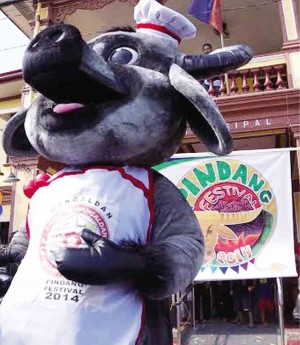‘Ikong’ becomes pride of this Pangasinan town

IKONG the Carabao is the ambassador of goodwill for the meat industry in Mangaldan, Pangasinan. MARKFIL TERSOL/CONTRIBUTOR
There is an instant celebrity in Mangaldan town in Pangasinan province. His name is Ikong ya Duweg (Ikong the Carabao), the official mascot of the Pindang Festival.
“Mangaldan is known for its tastiest pindang or tapa (dried carabao meat). This may be because we always use fresh meat. And of course, this industry was handed down to us by our ancestors,” Mayor Bonafe Parayno said.
Shortly after Ikong was introduced at the festival’s kick off ceremony on Saturday, children and their parents took turns in posing with the mascot for souvenir photos.
“He is the ambassador of goodwill of this town’s meat industry. In every event of our festival, Ikong will be there, wearing different costumes,” Parayno said.
Jonas Dizon, event director, said Ikong wore an apron and a toque on Saturday
Article continues after this advertisementbecause the events at that time involved cooking, such as “101 Ways to Cook Pindang” and “Pindang Rodeo.”
Article continues after this advertisement“During the parade on March 7, he will be dressed like a farmer, like a rural folk,” Dizon said.
Standing about six feet, Ikong is made of foam, rubber and gray furry fabric. “It took us three days to create him, although the conceptualization took us a longer time,” Dizon said.
The mascot was named after Rodolfo “Ikong” Elcano, village chief of Guilig, where the town’s slaughterhouse is located.
‘Masa’ appeal
“But aside from that, we thought that the name Ikong is masa (appeals to the masses) enough. Ordinary people can easily identify with him because the name is masa,” Dizon said.
According to a report posted on Mangaldan’s official website, at least 20 carabaos are butchered every day in the town’s abattoir.
“These carabaos come from different Pangasinan towns and cities that do not have abattoir. Carabaos are butchered here but are sold in their own public markets,” Dizon said.
The abattoir gave birth to the town’s pindang industry and other meat products.
Dizon said pigar-pigar, the deep-fried beef or carabao meat that has become a popular street food in Dagupan City, originated from his town.
‘Beng-beng’
“We called it beng-beng. This is the meat in the carabao’s abdomen, which is soft. This was cooked here in the public market and people from Dagupan City came here to eat,” Dizon said.
But as time passed, he said, some entrepreneurs in Dagupan came to buy meat and cooked it there, calling it pigar-pigar.
“Beng-beng is still a thriving industry here in our public market. It’s available from 11 p.m. up to dawn and people from nearby towns still come to eat,” Dizon said.
Another meat product that originated from Mangaldan is the sausage-shaped batotay, which is made of ground beef and carabao meat.
“It’s only in our town where you can find it. Longganisa (native sausages) are different because these are usually made of one kind of meat, say, chicken or pork,” Parayno said.
Roberto Tamondong, municipal agriculturist, said that despite the big number of carabao being butchered here every day, he makes sure that these were the nonbreedable carabaos.
“We follow the provincial ordinance strictly. We make sure that we don’t contribute to the dwindling carabao population in Pangasinan,” Tamondong said.
Last month, the Philippine Carabao Center said that in 10 years, carabaos will be gone in Pangasinan if butchering is not regulated.
“We celebrate the Pindang Festival as a tribute to the carabao that has given us livelihood. This is also to honor [people in] our meat industry,” Parayno said.